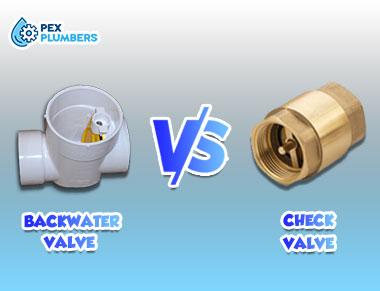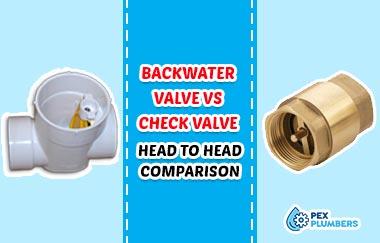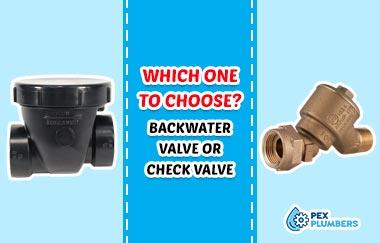Despite different names; these two valves have almost the same purpose in a drainage system. They prevent liquid from going backward by all means, which is known as backflow prevention.

These valves also have similarities in their working principles; we are going to reveal which in a moment.
This comparative discussion between the backwater valve vs check valve will give you an overall idea of the design, working principle, and benefits of these two valves.
Plus, you can easily determine which valve to choose in which case. Without any further due, let’s get into the pipeline.
Comparison Chart For Backwater Valve and Check Valve
We tried to give you a side-by-side comparison between these two valves here. Take a quick look to understand them better.
| Aspects | Backwater Valve | Check Valve |
| Primary Function | Primary Function | Force liquid in one direction |
| Field of Use | High-risk area | Low-risk area |
| Working Pressure Level | Moderate to high | Low to moderate |
| Chance of Failure | Low | Moderate |
Overview of Backwater Valve
Different backwater valve models are available in the market. Though they differ in design and other aspects, their functions are usually the same. The most common type is the flapper type valve that has a hinged flap positioned against a rubber seat.
If liquid flows from the right direction, the flap opens, and the flow continues. But if the liquid flow is from the wrong direction, the flap will be closed against the seat, and nothing will pass through.
This way, backwater valves ensure a clean water supply on your property. Ball float valves are also common where the valve gate is opened or closed using a heavy ball.
Under a high-pressure flow, the ball gets displaced, and the flow continues. When the flow is under the optimum level, the ball goes back to its position and closes the valve.
Uses of Backwater Valve
The backwater valve is the backbone of the safety of a drainage system in your residential or commercial spaces. This one-way valve is responsible for preventing the backflow of sewage or other liquid into the drainage system.
It also protects the drainage system from flooding during heavy rain. These valves are usually fitted at the lowest point of the plumbing so that no sewage from external drains can cause backflow into the drainage system of your house.
Backwater valves typically have a swing design to prevent liquid from getting in with the help of a hinged flapper.
Overview of Check Valve
All the check valves out there do the same thing, but their working principle or design might vary a bit. The most common check valve is the swing type check valve.
It has a flat component that swings back and forth inside the valve. When the water pressure from the right side increases, the valve opens instantly. But if the pressure falls, the valve will close immediately.
If the water flow is from the wrong direction, the seat will prevent the swing flap from opening. Lift type and ball type check valves are also common. Ball-type check valves are similar to ball-type backwater valves.
Lift type check valves use the plug and socket design to prevent unwanted water or liquid flow through the drainage system.
Uses of Check Valve
Check valves are used to protect your sewage line from water or liquid backflow in the case of flooding or rainstorm. It is a common component of the plumbing system at the point of discharge.
Due to the check valve at this point, the effluent is prevented from draining back into the system. As the drainage slurry can contaminate the water flow of your residential or commercial space, a check valve has an important role here.
They also protect sewage pumps from unwanted damage caused by hydraulic shocks. The use of energy to re-pulp the sewage is also reduced because of these check valves.
How They Differ: Backwater Valve Vs. Check Valve

As these two valves work similarly, comparing them head to head isn’t easy. Still, we tried to present all the relevant information in this form so that you can easily differentiate them. Check them out.
Design
Check valves and backwater valves have almost the same design and working principle. Both of them work to prevent the backflow of water or liquid into the drainage system. A 4-inch sewer check valve can come in different types, and so is a backwater valve.
Application
This is the main difference between these two valves. A check valve is usually used at the source of a drainage or sewage pump to control the backflow.
On the other hand, A 4″ backwater valve can be used in many different cases. It is generally installed at the lowest point of the plumbing system.
Interchangeability
Though these valves have similar designs, they aren’t interchangeable. You need to use the right type of valve in required cases. Backwater valves can handle higher pressure than check valves, so they are mostly used in high-risk areas.
Which One to Choose?

As we have already mentioned, these valves aren’t alternatives to each other, and they aren’t interchangeable. So, you can’t pick one between these two. What you need to know is their types and when to choose which.
Usually, both valves are required in the plumbing system of residential or commercial spaces if it is connected to the municipality sewage line.
The backwater valve works at the security level, and the check valve works at the clearing level. So, you need to pick the right valve for the right purpose.
Conclusion
Understanding backwater valve vs check valve isn’t that difficult because both work on the same principle. They are just used in different case scenarios to make sure nothing unwanted comes back into the drainage line.
Correctly installing them is also crucial so that they can protect your sewage system from catching up with problems. Learn about their purposes and make sure you are choosing the right valve when needed.
Relevant Article:
- How to Connect ABS to PVC?
- Funny Pipe vs Poly Pipe
- A Buying Guide of Top Quality P Trap
- PEX Shower Valve Buyers Guide
- Top 10 List of Air Admittance Valve

Hey! I’m Leanda Bailey. I’m here to explain every plumbing installation and repair you may have in your kitchen or bathroom. Also, I’ll try to find you the best products on the market for your plumbing work.
